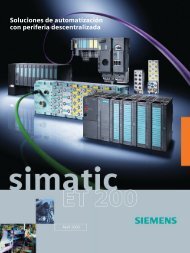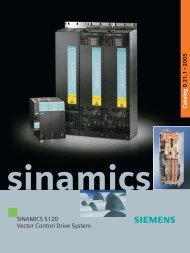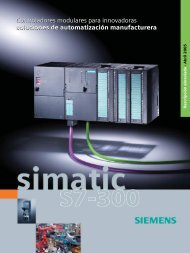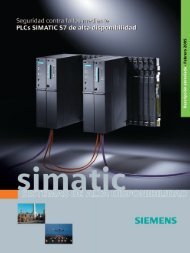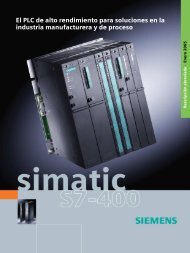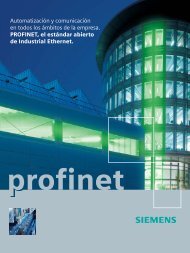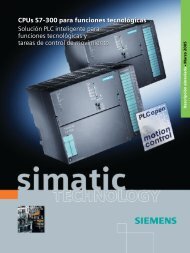Power supplies SITOP power LOGO!Power Catalog K T 10.1 2004
Power supplies SITOP power LOGO!Power Catalog K T 10.1 2004
Power supplies SITOP power LOGO!Power Catalog K T 10.1 2004
You also want an ePaper? Increase the reach of your titles
YUMPU automatically turns print PDFs into web optimized ePapers that Google loves.
Technical information and configuration<br />
Possible system disturbances and causes<br />
■ Overview<br />
The quality of the mains voltage has become a decisive factor in<br />
the functioning, reliability, maintenance costs and service life of<br />
highly sensitive electronic installations and devices (computers,<br />
industrial controls, instrumentation, etc.).<br />
Mains disturbances cause system failures and affect the function<br />
of plants as well as electronic consumers. They can also<br />
result in total failure of the installation or equipment.<br />
The most frequent types of disturbance are:<br />
• Long-term overvoltages<br />
• Long-term undervoltages<br />
• Burst interference and transients<br />
• Voltage reduction and surges<br />
• Electrical noise<br />
• Momentary mains breaks<br />
• Long-term mains breaks<br />
Mains disturbances can be caused by a number of things, e.g.:<br />
• Switching operations in the supply system<br />
• Long cable paths in the supply system<br />
• Environmental influences, such as storms<br />
• Mains overloads<br />
Typical causes of mains disturbances generated in-house are:<br />
• Thyristor-controlled drives<br />
• Lifts, air-conditioning, photocopiers<br />
• Motors, <strong>power</strong> factor correction equipment<br />
• Electrical welding, large machines<br />
• Switching of lighting equipment<br />
Disturbances in mains voltages can occur individually or in combination. Possible reasons for these disturbances and reactions<br />
can be:<br />
Mains disturbances<br />
Overvoltage<br />
Over a long period, the mains voltage is exceeded by<br />
more than +6% (acc. to DIN IEC 60038)<br />
Undervoltage<br />
Over a long period, the mains voltage is reduced by<br />
more than 10% (acc. to DIN IEC 60038)<br />
Burst interference<br />
Energy-rich impulses (e.g. 700 V/1 ms) and energypoor<br />
transients (e.g. 2500 V/20 µs) result from switching<br />
operations in the supply system<br />
Voltage reduction and surges<br />
The voltage level changes suddenly and in an uncontrolled<br />
manner, e.g. due to changes in loading and<br />
long cable runs<br />
Electrical noise<br />
A mix of frequencies superimposed on the mains due<br />
to bad grounding and/or strong HF emitters,<br />
such as television transmitters or storms<br />
Voltage interruption<br />
Short-term interruption of the mains voltage (up to<br />
10 ms), due to short-circuiting in neighboring supply<br />
systems or starting of large electrical machines<br />
Voltage interruption<br />
Long interruption of the mains voltage (longer than<br />
10 ms)<br />
Mains disturbances and effects<br />
Percentage of total<br />
disturbance<br />
approx. 15% - 20%<br />
approx. 20% - 30%<br />
approx. 30% - 35%<br />
approx. 15% - 30%<br />
approx. 20% - 35%<br />
approx. 8% - 10%<br />
approx. 2% - 5%<br />
Effect<br />
Can result in overheating and even thermal destruction of<br />
individual components. Causes total failure.<br />
Can result in undefined operating states for loads. Causes<br />
data errors.<br />
Can result in undefined operating states for the loads and<br />
can lead to the destruction of components.<br />
Can result in undefined operating states and destruction of<br />
components. Causes data errors.<br />
Can result in undefined operating states for loads. Causes<br />
data errors.<br />
Can result in undefined operating states for loads especially<br />
those with insufficient mains buffering. Causes data errors.<br />
Can result in undefined operating states for loads especially<br />
those with insufficient mains buffering. Causes data errors.<br />
The <strong>SITOP</strong> product family offers a range of possibilities for minimizing or preventing the risk of mains disturbances at the planning<br />
stage.<br />
14<br />
Siemens KT<strong>10.1</strong> · <strong>2004</strong> 14/9




